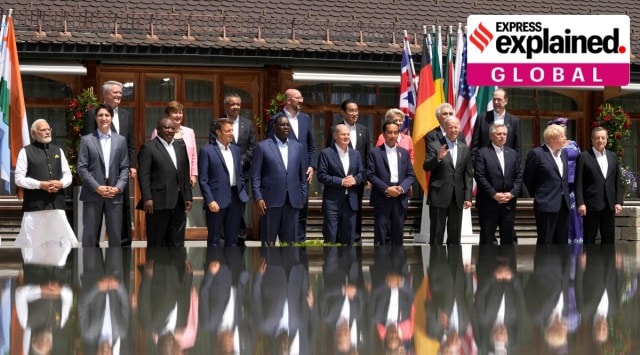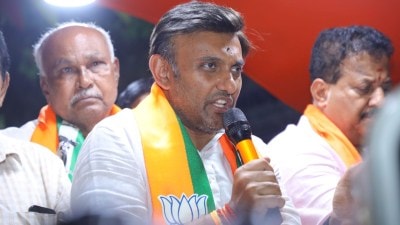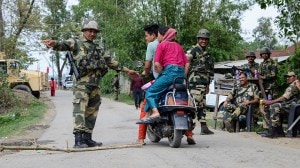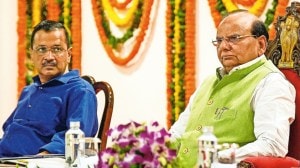- India
- International
Explained: The G7’s infrastructure investment plan to counter China’s Belt and Road Initiative
The infrastructure plan was first announced in June 2021 during last year’s G7 Summit in the UK. Back then, US President Joe Biden had called it the Build Back Better World (B3W) framework.
 U.S. President Joe Biden, front fourth right, waves as he poses with G7 leaders and Outreach guests for an official group photo at Castle Elmau in Kruen, near Garmisch-Partenkirchen, Germany, on Monday, June 27, 2022. (AP)
U.S. President Joe Biden, front fourth right, waves as he poses with G7 leaders and Outreach guests for an official group photo at Castle Elmau in Kruen, near Garmisch-Partenkirchen, Germany, on Monday, June 27, 2022. (AP)The G7 countries, who are meeting during the ongoing Leaders’ Summit in Germany, have officially launched the Partnership for Global Infrastructure and Investment (PGII), a joint initiative to fund infrastructure projects in developing countries. The project, launched on June 27, is being seen as the bloc’s counter to China’s ‘Belt and Road Initiative.
US President Joe Biden said on Twitter, “Collectively, we aim to mobilise nearly $600 billion from the G7 by 2027 to invest in critical infrastructure that improves lives and delivers real gains for all of our people.”
What is G7’s PGII?
The infrastructure plan was first announced in June 2021 during last year’s G7 Summit in the UK. Back then, US President Joe Biden had called it the Build Back Better World (B3W) framework. However, it did not register much progress and details regarding the plan’s time period or funding source were unclear.
This time around, the initiative was officially launched as PGII.
Essentially, G7 countries — the US, Canada, Italy, the UK, France, Germany, and Japan — and the EU have noted the infrastructure projects being undertaken and funded by China at a global level and decided to present their alternative mechanism for it.

The stated purpose of both the PGII and the BRI is to help secure funding for countries to build critical infrastructure such as roads, ports, bridges, communication setups, etc. to enhance global trade and cooperation.
However, the G7 say their initiative is meant to be transparent, focused on building climate change-resilient infrastructure, and help in achieving objectives of gender equality and health infrastructure development.
“When we demonstrate all that democracies have to offer — I have no doubt that we will win the competition every time,” said Biden in a speech announcing the plan on Monday. He added that around a dozen projects are already underway, with financing from both government and the private sector.
The US president also mentioned that the fund does not mean “charity or aid”, but loans, and will be beneficial for both the countries lending and receiving them.
Where are funds being directed under the plan?
In India, the US International Development Finance Corporation, the development bank of the country, will invest up to $30 million in the Omnivore Agritech and Climate Sustainability Fund 3, described as “an impact venture capital fund that invests in entrepreneurs building the future of agriculture, food systems, climate, and the rural economy,” as per a statement by the White House.
The fund will invest in companies that “increase food security and promote both climate resilience and climate adaptation in India, as well as improve the profitability and agricultural productivity of smallholder farms.”
Apart from India, projects have been announced in countries across West Africa, Southeast Asia, and South America.
What has been China’s response to the PGII announcement?
When asked about the PGII, Chinese foreign ministry spokesman Zhao Lijian, according to Reuters, said: “China continues to welcome all initiatives to promote global infrastructure development.”
“We believe that there is no question that various related initiatives will replace each other. We are opposed to pushing forward geopolitical calculations under the pretext of infrastructure construction or smearing the Belt and Road Initiative,” he added.
What is China’s BRI?
China began the Belt and Road Initiative in 2013 under its President Xi Jinping. It aims to revive the ancient trade routes crossing to and from China–from Rome in Europe to East Asia.
Under this, the Chinese government helped in providing loans for infrastructure projects to various countries, and in many cases, Chinese companies were awarded contracts for carrying out the work. This helped China mark its footprints at a global level.
However, China was criticised in the West and by some other countries for providing unsustainable debts to countries that will be unable to repay them. According to a 2019 World Bank report, among the 43 corridor economies for which detailed data was available, 12 could face a situation where debts were not sustainable, which could lead to public assets being handed over to foreign contractors or China itself.
The report adds if issues of environmental degradation, high debts, and corruption are successfully countered and the BRI is fully implemented to its potential, it could increase trade between 1.7 and 6.2 percent for the world, increasing global real income by 0.7 to 2.9 percent.
In 2019, Chinese Foreign Minister Wang Yi said at a press conference that since the launch of the BRI, “the trade volume between China and countries joining the BRI has surpassed 6 trillion US dollars, with more than 80 billion US dollars of Chinese investment in those countries,” creating nearly 300,000 jobs for local people.
India opposed the BRI as it included the China-Pakistan Economic Corridor, which connected Kashgar in China with the Gwadar port in Pakistan via Pakistan-occupied Kashmir. India’s External Affairs Minister S Jaishankar said in 2021: “Any serious connectivity initiative must be transparent and conform to the most basic principle of respect for sovereignty and territorial integrity.”
Newsletter | Click to get the day’s best explainers in your inbox
Is there any overlap between the two schemes?
While the US has been critical of BRI, other countries of the G7 have had varying responses to it. Italy became the first G7 member to be a part of the BRI in 2019, and the British finance minister Philip Hammond described the policy as a “vision” in the same year, though it is not officially a part of the BRI.
“The UK is committed to helping to realise the potential of the BRI and doing so in a way that works for all whose lives are touched by the project,” he said, as reported by Reuters.
Germany and France, while not directly participating in the BRI, have also partnered with China in building rail networks and other projects for connectivity.
More Explained
EXPRESS OPINION
Apr 27: Latest News
- 01
- 02
- 03
- 04
- 05










































